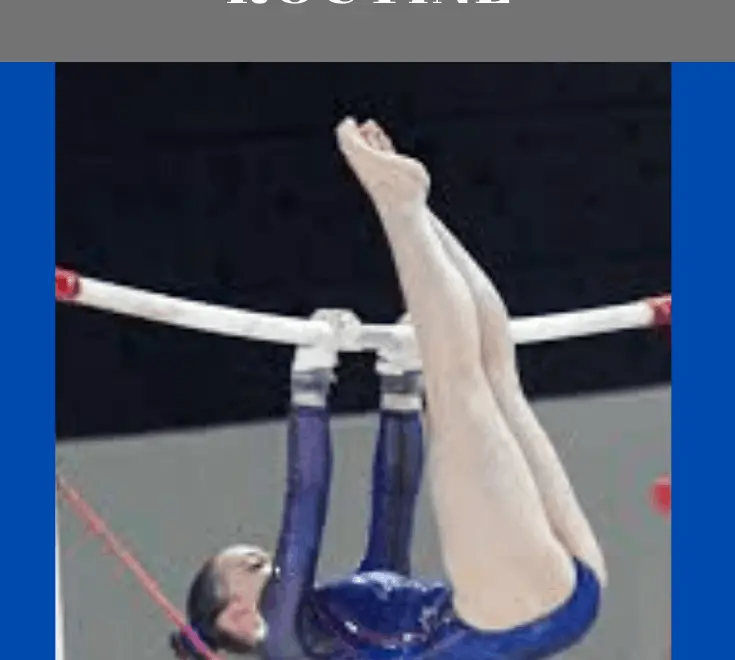This post has been updated to reflect the 2021 compulsory updates, and the updates from the 2022 minutes.
Where I live in Ohio, Level 3 is often the first level gymnasts compete. For many Level 3 gymnasts, learning to swing bars can be really tough! Bars requires a lot of upper-body strength along with good timing.
Some might wonder, if the gymnast is still developing the necessary strength, is there any hope for them on bars? I say, definitely! Every gymnast can make improvements to their bar routine. Here is a breakdown of the Level 3 bar routine, including large and small errors that can make a big difference in a bars score.
How a Level 3 Bar Routine Is Evaluated
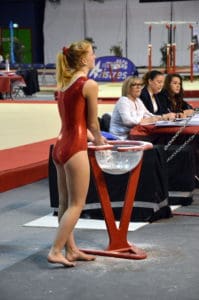
Each skill in the Level 3 routine has specific deductions that can be taken on that skill. These deductions relate to the technique that is expected for the skill.
In addition to these deductions, there are general execution deductions that can be applied to each skill in the routine. We’ll talk more about those in a minute.
Finally, a judge can take general routine deductions, which are deductions for the overall impression of the routine. If you’re curious about that, here’s an article that discusses general deductions in detail.
If your gymnast is looking for a bar for home practice, check out the Guide to Home Gymnastics Equipment for some recommendations.
Most Level 3 gymnasts don’t need grips yet, but if your coach has recommended a pair, check out The Best Gymnastics Grips for some ideas!
General Execution Deductions
General execution deductions are deductions that can be taken on any major element (skill) in a routine. Here is a list of general execution deductions that could occur during a bar routine:
- Foot form – 0.05
- Leg separation – Up to 0.20
- Body alignment/position/posture in major elements – Up to 0.20
- Bent arms or legs (max deduction at 90 bend) – Up to 0.30
- Balance errors – Up to 0.30
- Fall (on or off the apparatus) – 0.50
- Repositioning of hands in support – 0.10
- Alternate hand grasp – 0.20
- Extra cast or swing – 0.30 (maximum 0.50 if >1)
- Supplementary support to regain position – 0.30
- Brush/touch on apparatus or mat with foot or feet – Up to 0.10
- Hit on apparatus with foot – 0.20
- Hit on mat with feet – 0.30
- Full weight on mat with feet – 0.50
You can see that larger errors will result in larger deductions. It’s more costly to fall off the apparatus than to forget to point your toes, but small errors repeated over several skills can also add up. Let’s think about the gymnast who has a small knee bend and a small arm bend (0.10 each) on every skill in her routine. After making these errors on all 8 skills in the routine, she has just lost 1.6 in deductions!
On bars, using good technique and body position will minimize many deductions. The first suggestion I would give anyone looking to improve their score is to look at a video of your routine, and try to clean up little knee bends, arm bends, and foot form errors. This can make a big difference in your score!
Now, let’s look at some specific deductions for each skill.
Level 3 Bar Skills
Level 3 gymnasts have two options for mounting the bar: a glide swing, pullover mount (just like Level 2), or a glide kip. Both mounts have the same value, and the gymnast’s Start Value of her routine will be 10.0 using either option.
Mount Option 1: Glide swing, pullover
Glide Swing
The gymnast is expected to jump off two feet during her glide, and will lose 0.10 if she takes off from one foot. If she performs a run-out glide, she will be subject to a 0.30 deduction. The feet should lead into the glide, and remain in front of the body for the duration of the swing (up to 0.10 for not leading with the feet). There is a deduction of up to 0.20 for failure to extend the body during the glide. If the gymnast performs a straddle glide, she must close her legs on the backswing, or she will incur a 0.10 deduction. Bending the legs on the backswing will lead to a deduction of up to 0.30.
Throughout the glide, the gymnast is expected to maintain a straight-hollow body position through her torso, with the head in neutral. Her arms and legs should remain straight, with toes pointed. Legs should be together throughout the swing, for a piked glide, and during the backswing only for a straddle glide. Feet should not touch the mat. Deductions can occur for all of these errors, and they are listed under the general execution deductions.
Pullover
A common neutral deduction (taken from the average by the chief judge) is failure to remove the board or mounting mat after the glide. If the gymnast completes her glide and lands back onto the mounting apparatus, she will get a 0.30 deduction for failure to remove the board/mount trainer.
The gymnast is expected to move smoothly from the landing of the glide into the takeoff of the pullover. She will get a 0.10 deduction for each step, jump, or hop. Both legs should lift simultaneously into the pullover (0.30 deduction). The pullover should finish in an extended front support (up to 0.10 deduction). If the chin rests on the bar, the gymnast would receive a 0.30 deduction for a supplementary support.
Mount Option 2: Glide kip
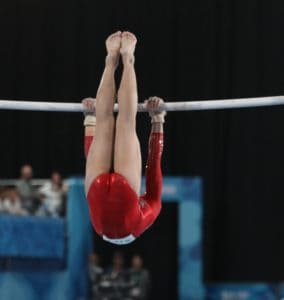
The glide kip has all of the same specific element deductions as the glide swing, with the only exception being the 0.30 for knee bend on the backswing, as there is no backswing during a kip. The specific deductions for the glide kip are:
- Lack of two foot takeoff – 0.10
- Run out glide – 0.30
- Failure to lead with the feet – Up to 0.10
- Lack of extension of glide – Up to 0.20
- Failure to close legs on straddle glide – 0.10
Some of the most common general execution deductions on a kip are bent knees during the glide and bent arms at the end of the kip. If the gymnast finishes the kip with bent arms, it is very difficult for her to connect the kip into the cast. Unless the kip, cast is near-perfect, I recommend using the glide, pullover mount for Level 3 bars, as there are usually fewer deductions on that mount.
Cast
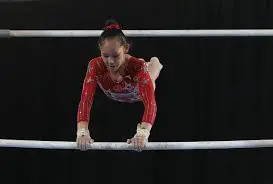
If the gymnast “pumps” her legs prior to the cast, she will be deducted 0.30 for an extra cast. If she performs the glide kip mount, she should connect the kip immediately to the cast. If she performs the glide, pullover, she should finish in an extended front support, then immediately bring the legs backward to perform the cast.
There are only two specific deductions for the cast: up to 0.20 for incorrect body alignment, and up to 0.10 for lack of control when returning to the bar. General deductions will also apply to the cast. Common deductions include bent arms, bent legs, leg separations, and foot form.
There is no amplitude requirement for the cast, so there are no deductions for amplitude. The only requirement is that the hips leave the bar. If the cast is too low, however, the quality of the back hip circle may be sacrificed. The cast should be performed with straight arms, straight legs, feet pointed and together, and a straight-hollow body position throughout.
Back hip circle, Back hip circle
Next, the gymnast performs two consecutive back hip circles. If the gymnast does not move continuously into the second back hip circle, an up to 0.20 deduction can be applied.
During the back hip circles, the gymnast should maintain a straight-hollow body position throughout (up to 0.20 each) and a neutral head position (up to 0.10 each). Her hips/upper thighs should stay in contact with the bar throughout the circles (up to 0.20 each). If the circle is not continuous, a deduction of up to 0.10 could be applied each time. Of course, deductions can also be applied for bent arms and legs, leg separations, and foot form.
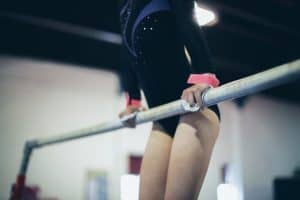
Front hip circle, small cast
The gymnast should immediately begin her front hip circle after she shows the front support position at the end of the second back hip circle. She could incur an up to 0.10 deduction for failure to show a straight-hollow body position into the front hip circle. If she omits the small cast, she would receive a 0.20 deduction. She should show control upon returning to the bar, or an up to 0.10 deduction could be taken. If she does not return to the bar (performs an immediate squat on), she will receive a 0.50 deduction.
Other common execution deductions for the front hip circle are bent arms, bent legs, leg separation, and poor body position on either the front hip circle or cast. If the gymnast performs more than one cast, or stops and pumps her legs before the dismount, a 0.30 extra swing deduction would be applied.
Squat OR pike on, straight jump dismount
To initiate the squat on, the gymnast should cast immediately into the squat on. She should swing her legs backward (not just lift her hips), or a 0.05 deduction can be applied. The feet should be placed next to each other, in between the hands, to avoid a 0.20 deduction for alternate foot placement. During the jump, the gymnast should show a straight-hollow body position (up to 0.20).
The gymnast is not allowed to touch the high bar during the jump. There is a 0.50 deduction if there is any contact with the high bar. There is also a 0.50 deduction if the gymnast does not jump toward the high bar.
General deductions apply, as always. In addition, the gymnast should maintain good posture on landing (up to 0.20 deduction). Steps, hops, or a deep squat are also deductions, depending on the depth of the squat (up to 0.30) and the number of steps (up to 0.40).
Final Thoughts
When looking at a Level 3 bar routine, a straight body position, straight arms and legs, and good rhythm between elements are the biggest factors that determine a great routine from one that is not. If the gymnast has good major elements, but her score is still lower than expected, make sure that her rhythm is good between skills, and that everything looks sharp and dynamic. That Level 3 routine will be top-notch in no time!
Coaches, what are your favorite drills for these Level 3 skills?
Further Reading
How to Perfect Your Level 2 Bar Routine
5 Tips for a Great Level 3 Vault
How to Perform the Best Level 3 Beam Routine
The Ultimate Guide to Gymnastics Grips
How to Perfect Your Level 4 Bar Routine
How to Perfect Your Level 5 Bar Routine
Preview of 2021-2029 Compulsory Skills
General Categories for Exemplary Compulsories
References:
USA Gymnastics Compulsory Handbook, 2021-2029.
